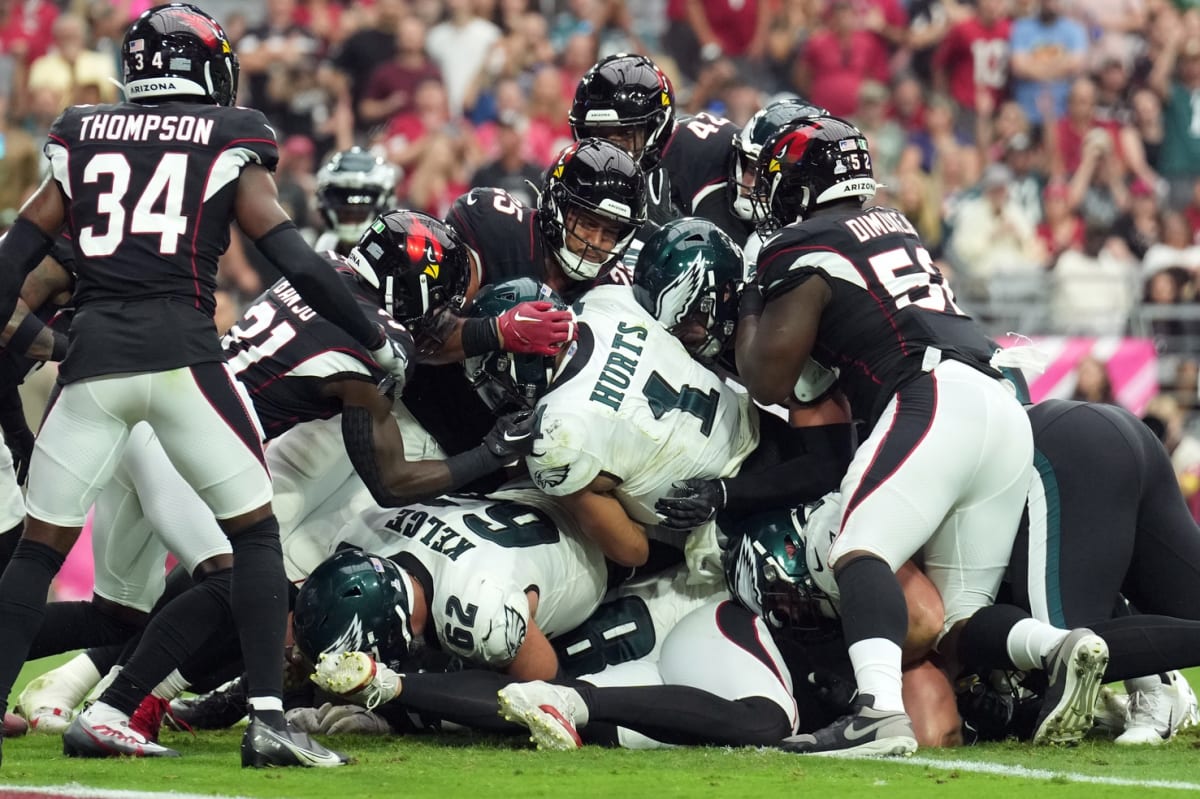Self-respecting sportswriters—assuming any exist—could not possibly applaud Jason Kelce’s retirement. The former Philadelphia Eagles center always seemed to have the rare understanding that journalists ask questions because they want to hear the answer, and fans who grumble are just customers who care. Kelce will surely land with a TV network or a streaming platform, though in an ideal world, teams would get an extra roster spot for players whose only duties are media sessions, and Kelce would continue going to the Eagles locker room after games to take off his shirt and explain what just happened.
Kelce will be missed—perhaps even more, as my colleague Conor Orr wrote Monday, than people realize. But by retiring, Kelce might answer a question that even he could not completely answer while he was playing: Is the tush push about the push of the tush, or the tush in front of the push?

Joe Camporeale/USA TODAY Sports
The Eagles have famously thrived behind Jalen Hurts’s behind, with a play that turns anything-and-1 into first-and-10 almost every time. (The play did fail in the Eagles’ playoff loss to the Tampa Bay Buccaneers this year, but by that point in the season, the Eagles had stopped playing football.) The Eagles have been so successful with the tush push that they spawned discussion about banning the play—the thinking being that if a player touches another player in a way that cannot possibly injure him, it does not belong in the game.
The Eagles have insisted that the play is not a cheat code; it’s just a play they execute extremely well. As Philadelphia coach Nick “You Want A Piece of Me?” Sirianni said last season, “If everybody could do it, everybody would do it.”
I agree. It would be absolutely absurd to ban a play that one team uses effectively. If that’s the standard, then Patrick Mahomes gives the NFL something new to ban every week.
[ 2024 NFL Free Agency: Latest News & Analysis ]
The Eagles have succeeded for two reasons. One is that Hurts has such powerful legs and is so good at sneaks. The other is that Kelce was the best in the league at snapping, staying low, and driving a defender backward. It is the kind of athletic move that is easy to overlook in a league with flashy athletes such as Tyreek Hill and Christian McCaffrey. But Kelce’s unique ability probably played a much bigger role in the play’s success than the push itself.
We will find out this fall. The Eagles still have Hurts, and they still have a staff that believes it teaches the play better than anyone else. But they will not have Kelce, and it may cost them dearly.
The push only gains one to three yards, but it has an enormous effect on games. Every failed fourth-down play is essentially a turnover, and the Eagles converted 73 percent of their fourth-down attempts last season, the best rate in the league.
In 2023, the Eagles achieved 127 first downs on third or fourth down, more than any other NFL team. The season before—when they went to the Super Bowl—the Eagles achieved 122 first downs on third or fourth down, which was also the most in the league.
NFL games are won on the margins, and over the past two seasons, the Eagles might have been the best example of that: a yard here, a yard there, a yard whenever they needed it. What happens if the Eagles are just O.K. on short-yardage runs? Will Hurts, A.J. Brown, DeVonta Smith and Dallas Goedert make up the difference through the air?
We could find out how good Hurts really is. We could also realize that he, not Kelce, was the primary reason the tush push succeeded. But what we might learn instead is that the best center in the league was the key to the push—and that the play is crucial to the Eagles’ offense.







